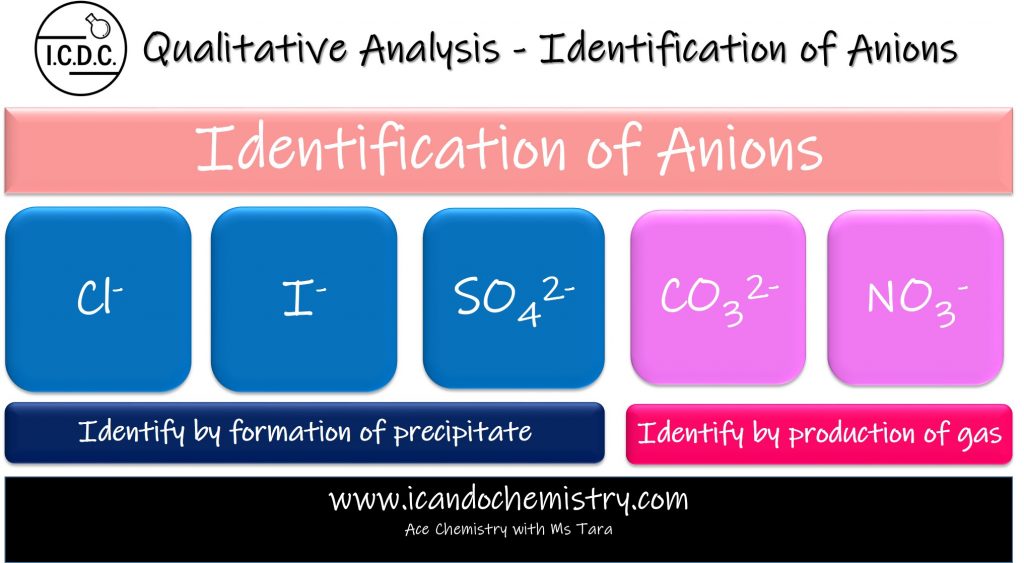
In this article, we focus on the identification of the following anions: chloride, iodide, sulfate, nitrate and carbonate.
Identify by formation of precipitate
Anion: Chloride (Cl–)
Test: Add dilute nitric acid, then aqueous silver nitrate.
Chemical equation: NaCl (aq) + AgNO3 (aq) → AgCl (s) + NaNO3 (aq)
Observation: White precipitate of silver chloride is formed
We can also add aqueous lead(II) nitrate to test for chloride ions.
Test: Add dilute nitric acid, then aqueous lead(II) nitrate.
Chemical equation: 2NaCl (aq) + Pb(NO3)2 (aq) → PbCl2 (s) + 2NaNO3 (aq)
Observation: White precipitate of lead(II) chloride is formed
Anion: Iodide (I–)
Test: Add dilute nitric acid, then aqueous silver nitrate.
Chemical equation: NaI (aq) + AgNO3 (aq) → AgI (s) + NaNO3 (aq)
Observation: Yellow precipitate of silver iodide is formed
Alternatively, we can add aqueous lead(II) nitrate to test for iodide ions.
Test: Add dilute nitric acid, then aqueous lead(II) nitrate.
Chemical equation: 2NaI (aq) + Pb(NO3)2 (aq) → PbI2 (s) + 2NaNO3 (aq)
Observation: White precipitate of lead(II) iodide is formed
Anion: Sulfate (SO42-)
Test: Add dilute nitric acid, then aqueous barium nitrate.
Chemical equation: Na2SO4 (aq) + Ba(NO3)2 (aq) → BaSO4 (s) + 2NaNO3 (aq)
Observation: White precipitate of barium sulfate is formed.
Alternatively, we can add aqueous lead(II) nitrate to test for sulfate ions.
Test: Add dilute nitric acid, then aqueous lead(II) nitrate.
Chemical equation: Na2SO4 (aq) + Pb(NO3)2 (aq) → PbSO4 (s) + 2NaNO3 (aq)
Observation: White precipitate of lead(II) sulfate is formed
In all cases, dilute nitric acid is added to remove any interfering ions that can form precipitate with the added reagent.
For example, any carbonate ions present would react with aqueous silver/barium/lead(II) nitrate to form white precipitate of silver/barium/lead(II) carbonate. This results in a false positive test that we can avoid by adding dilute nitric acid. The carbonate will react with dilute nitric acid to form salt, carbon dioxide and water.
Identify by production of gas
Anion: Carbonate (CO32-)
Test: Add dilute hydrochloric acid. Pass gas given off into limewater.
Chemical equation: Na2CO3 (aq) + 2HCl (aq) → 2NaCl (aq) + H2O (l) + CO2 (g)
Observation: Effervescence is observed. Carbon dioxide gas forms white precipitate with lime water.
Chemical equation: Ca(OH)2 (aq) + CO2 (g) → CaCO3 (s) + H2O (l)
Lime water is calcium hydroxide. When acidic carbon dioxide gas is formed, it reacts with the basic calcium hydroxide to form calcium carbonate, which is the white precipitate.
Anion: Nitrate (NO3–)
Test: Add aqueous sodium hydroxide, piece of aluminium foil, then warm.
The aluminium powder is a powerful reducing agent. It reduces nitrate ions into ammonium ions, which will react with hydroxide ions to give ammonia gas when warmed.
Observation: Effervescence is observed. Ammonia gas turns moist red litmus paper blue.
